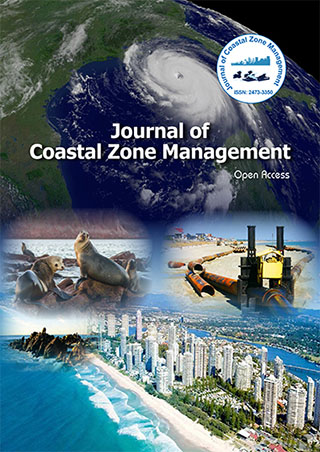Indexed In
- SafetyLit
- RefSeek
- Hamdard University
- EBSCO A-Z
- OCLC- WorldCat
- Publons
Useful Links
Share This Page
Journal Flyer

Open Access Journals
- Agri and Aquaculture
- Biochemistry
- Bioinformatics & Systems Biology
- Business & Management
- Chemistry
- Clinical Sciences
- Engineering
- Food & Nutrition
- General Science
- Genetics & Molecular Biology
- Immunology & Microbiology
- Medical Sciences
- Neuroscience & Psychology
- Nursing & Health Care
- Pharmaceutical Sciences
Commentary - (2024) Volume 27, Issue 3
Exploring the Functions, Interactions, and Biotechnological Applications of Microbial Diversity in Marine Environments
Mian Wu*Received: 16-Apr-2024, Manuscript No. JCZM-24-25568; Editor assigned: 19-Apr-2024, Pre QC No. JCZM-24-25568 (PQ); Reviewed: 02-May-2024, QC No. JCZM-24-25568; Revised: 09-May-2024, Manuscript No. JCZM-24-25568 (R); Published: 16-May-2024, DOI: 10.35248/2473-3350.24.27.628
Description
Microbial diversity in marine environments represents a wide reservoir of genetic and biochemical diversity, lead significant roles in ecosystem functioning, nutrient cycling, and biogeochemical processes. Understanding the functions, interactions, and biotechnological significant of marine microbes is essential for unlocking their ecological significance and harnessing their applications in various fields.
Marine environments harbor an immense diversity of microorganisms, including bacteria, archaea, viruses, and microscopic eukaryotes, adapted to a wide range of habitats, from surface waters to deep-sea hydrothermal vents. These microorganisms exhibit remarkable metabolic versatility, and allowing them to prosper in diverse environmental condition from extreme temperatures and pressures to low-oxygen and high-salinity environments.
Microbes play essential roles in marine ecosystems, driving key biogeochemical cycles, such as carbon, nitrogen, sulfur, and iron cycling. For example, marine bacteria and archaea are major contributors to carbon fixation and remineralization processes, influencing global carbon budgets and climate regulation. Nitrogen-fixing bacteria play a vital role in converting atmospheric nitrogen into biologically available forms, supporting primary productivity in marine ecosystems.
Furthermore, microbial interactions in marine environments are integral to ecosystem functioning and stability. Microbial communities engage in complex symbiotic, competitive, and mutualistic interactions, shaping community structure and dynamics. For instance, microbial consortia associated with marine invertebrates, such as corals and sponges; provide essential nutrients and protection against pathogens, contributing to host health and resilience.
Advancements in molecular biology and sequencing technologies have revolutionized our understanding of marine microbial diversity and function. Metagenomic, metatranscriptomic, and metaproteomic approaches allow researchers to study microbial communities in their natural habitats, revealing the metabolic significant, functional diversity, and ecological roles of individual microbial taxa.
The study of marine microbial diversity has significant implications for biotechnological applications, ranging from pharmaceuticals and bioremediation to renewable energy and biomaterials. Marine microbes produce a wealth of bioactive compounds with pharmaceutical properties, including antibiotics, antivirals, and anticancer agents, offering promising leads for drug discovery and development.
Furthermore, marine microbes play a vital role in bioremediation processes, degrading organic pollutants, hydrocarbons, and heavy metals in marine environments. Microbial bioremediation technologies offer sustainable and cost-effective solutions for cleaning up contaminated marine ecosystems and restoring ecosystem health.
Marine microbes also for the development of renewable energy sources, such as biofuels and biogas, through processes like anaerobic digestion and microbial fermentation. Additionally, marine microorganisms produce a diverse array of enzymes with industrial applications, including enzyme catalysts for biocatalysis, food processing, and biopolymer production.
The exploration of marine microbial diversity for biotechnological applications requires interdisciplinary collaboration between microbiology, biotechnology, ecology, and bioinformatics. By leveraging advances in genomic sequencing, synthetic biology, and bioinformatics, researchers can identify novel microbial strains, characterize their metabolic pathways, and engineer microbial systems for specific biotechnological purposes.
In conclusion, microbial diversity in marine environments represents a wide and untapped resource with immense ecological significance and biotechnological significe. Understanding the functions, interactions, and applications of marine microbes is essential for addressing pressing environmental challenges, advancing scientific knowledge, and harnessing the sustainable benefits of marine biotechnology.
Citation: Wu M (2024) Exploring the Functions, Interactions, and Biotechnological Applications of Microbial Diversity in Marine Environments. J Coast Zone Manag. 27:628.
Copyright: © 2024 Wu M. This is an open-access article distributed under the terms of the Creative Commons Attribution License, which permits unrestricted use, distribution, and reproduction in any medium, provided the original author and source are credited.
